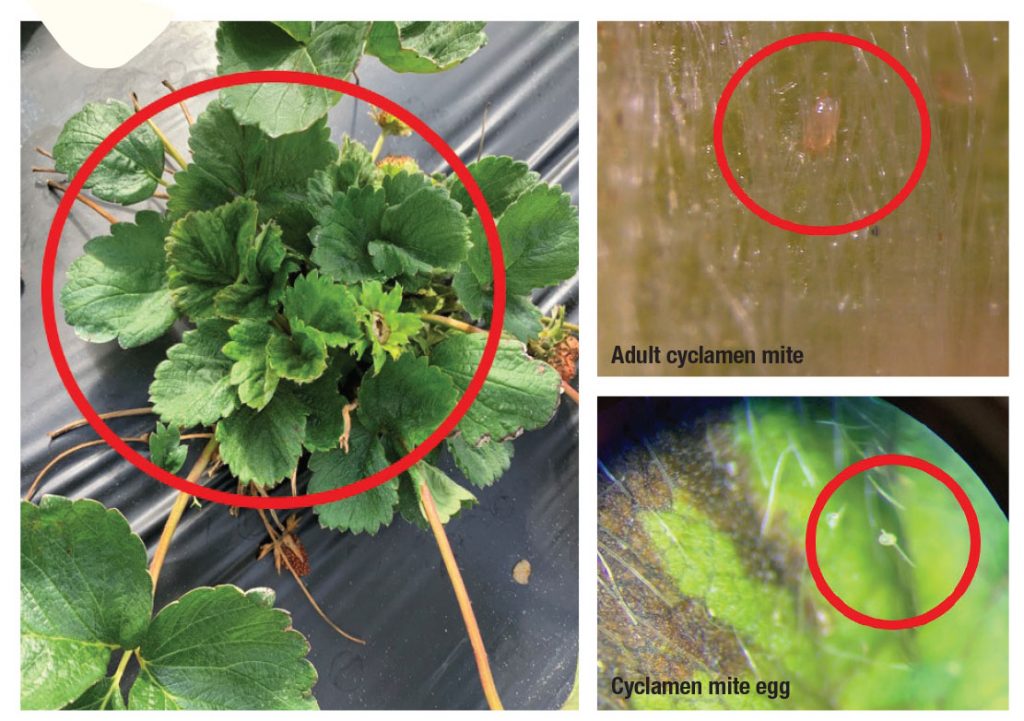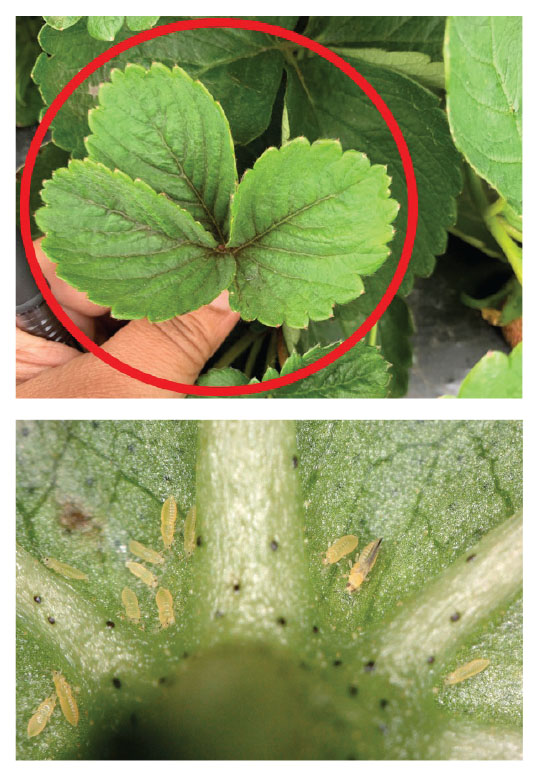
By Sriyanka Lahiri
Several arthropod pests occur in strawberries in Florida during the various stages of the crop cycle.
Cyclamen mites (Phytonemus pallidus), if present, originate from strawberry nurseries as hitchhikers on transplants. Thankfully, a very small percentage of growers reported a cyclamen mite infestation during the strawberry season of 2019–2020.
Soon after planting, armyworms (Spodoptera spp.), twospotted spider mites (TSSM, Tetranychus urticae) and the invasive polyphagous chilli thrips (Scirtothrips dorsalis) are typically found infesting plants.
TSSM can also arrive as hitchhikers on transplants, occasionally. The presence of armyworms on young foliage becomes immediately evident due to feeding holes left by their biting-chewing mouthparts. Both TSSM and chilli thrips feed on foliage using their piercing-sucking mouthparts. TSSM produce webbing on the surface of the foliage and lay eggs on these webs. However, chilli thrips differ in their oviposition practices.
The more devastating chilli thrips prefer feeding on the youngest open leaflets. Eggs are laid by the chilli thrips female into the leaf tissue using a saw-like ovipositor. This protects eggs from insecticides and predators. Both chilli thrips adults and larvae find refuge in concealed areas of the foliage, which makes them a very effective cryptic pest.
As plants progress toward flowering and fruiting, more thrips species appear, such as western flower thrips (WFT, Frankliniella occidentalis), common blossom thrips (F. schultzei) and Florida flower thrips (F. bispinosa) in addition to chilli thrips. Of these thrips species, both chilli thrips and WFT cause significant economic damage and develop resistance to insecticides easily.
DAMAGE
A cyclamen mite infestation can lead to severely stunted and crinkled leaves, aborted flowers, and bronzed and cracked fruits.

Chilli thrips cause necrosis at the site of feeding, which leads to darkening along the leaf mid-rib, followed by the spread of the dark coloration to lateral veins and petioles. Leaf bronzing, crinkling and deformation occurs during severe chilli thrips infestation.
Severe thrips and cyclamen mite infestations lead to bronzed and cracked fruits that are unmarketable.
An infestation of TSSM will lead to stippling of leaves initially. Uncontrolled TSSM populations become evident by the appearance of webbing.
MANAGEMENT
Management of cyclamen mites is best done with a preventive approach. Therefore, obtaining clean transplants is of utmost importance. Since all life stages of cyclamen mites show high mortality when exposed to hot water, a dip of frozen transplants into hot water at 111 °F for 10 minutes before planting may help. Alternatively, infested plants should be removed from the field.
The most significant early-season strawberry pest that is currently posing a management challenge in Florida is the invasive chilli thrips. Conventional insecticides are being used to manage thrips pests, but there are several naturally occurring beneficial insects that could be used. These include predators such as the big-eyed bug (Geocoris spp.) and the minute pirate bug (Orius insidiosus). Additionally, University of Florida Institute of Food and Agricultural Sciences (UF/IFAS) greenhouse experiments using potted strawberry plants have confirmed the efficacy of the WFT predator Amblyseius swirskii as effective for suppression of chilli thrips larvae.
An infestation of TSSM in open-field strawberries is best controlled by releasing the specialized predatory mite Phytoseiulus persimilis.
Armyworms are effectively managed by early-season application of biological insecticide formulations of Bacillus thuringiensis, subsp. kurstaki.
Pesticides registered for various strawberry pests are listed in the UF/IFAS Vegetable Production Handbook of Florida (https://edis.ifas.ufl.edu/pdffiles/CV/CV13400.pdf). It is important to select pesticides that are least harmful to beneficial arthropods, rotate modes of action and follow the label.









